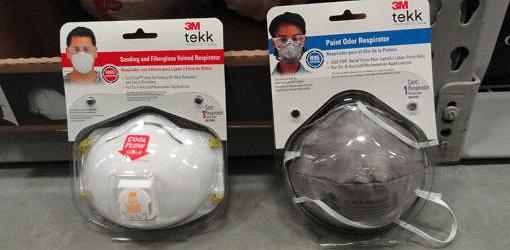
In addition to proper ventilation, understanding how to choose a respirator or dust mask will go a long way toward protecting your lungs and health.
Home and garden projects frequently involve exposure to harmful chemicals and toxins — such as paint fumes, solvents, dust, adhesives, pesticides, and caustic cleaning products. This is in addition to the annual assault homeowners face from pollen and allergens. So, it’s important to wear protection before you tackle these types of projects.
Respirators and dust masks aren’t all the same — there are different kinds to choose from, as well as a rating system for efficiency. At home and around the workshop, a particulate filter (dust mask) or chemical cartridge respirator should be all you’ll need.

Particulate Filters
Disposable dust masks are particulate filters, the most common type of air-purifying device for home use. Particulate filters can be disposable or reusable with replaceable filters. They cover your nose and mouth and provide protection from airborne particles — including dust, mists, liquids and some fumes — but they don’t protect you from gases or vapors.
Particulate filters are rated by the National Institute of Occupational Safety and Health according to what, and how much, they filter out. The rating has both a letter and number:

- N: Not oil-proof
- R: Oil resistant (up to 8 hours)
- P: Oil-proof (beyond 8 hours)
- Number: Particulate filters are rated 95, 97 or 100, which corresponds to the percentage of one-micrometer particles removed during clinical trials. A 95 rating means that the filter removes 95% of particles from the air. Filters rated 100 are considered High-Efficiency (HE or HEPA) filters.
What Type of Particulate Filter Should I Buy?
The most common rating for disposable dust masks is N95, which will filter 95% of airborne particles that are not oil-based. N95 covers most woodshop dust, allergens, and airborne diseases. Filters for painting are often rated R95, or higher to handle oil-based particles.
If you’re looking for the highest level of protection in the widest variety of situations, go for P100, which will filter out 100% of both oil-based and non-oil-based particles.
When choosing a dust mask, consider:
- Masks with an adjustable nosepiece offer a tighter fit.
- Disposable masks with foam face seals will be more comfortable and a little more effective.
- Masks with an exhalation valve will make breathing easier.
- For highly toxic particles (such as asbestos), choose a non-disposable mask with sealing gaskets.

Chemical Cartridge/Gas Mask Respirators
Chemical cartridge respirators contain special carbon-filtering material that absorbs gases and vapors from the air.
The replaceable cartridges are inserted in a mask that seals tightly around the edges to block out unfiltered air.
Cartridge respirators may be half-mask (covering only your nose and mouth) or full-face (for protection against chemicals that irritate the skin).
Chemical cartridge filters include:
- Chemical Cartridge: Block out vapors, but don’t have a separate prefilter to remove particles.
- Dual Cartridge: Include a replaceable pre-filter for particulates, giving you both types of protection. The particulate pre-filter will be rated just like any other particulate filter (see above).
- PAPR (Powered Air-Purifying Respirator): Have a battery-powered fan that blows air through the filter to make breathing easier.
What Type of Chemical Cartridge Respirator Should I Buy?
Before you can choose the right cartridge respirator, you need to know what toxins you will face. The cartridges are color-coded for specific purposes (such as organic vapors, ammonia, mercury, or acids).
If you don’t know, or if your project is likely to contain small amounts of different substances, choose a dual-cartridge respirator with a multipurpose chemical cartridge and a P100-rated particulate filter.

Guide to Respirators
The following chart will help you decide what kind of respirator you need:
| Substance | Type of Respirator | Rating (if applicable) |
|---|---|---|
| Acid Gases | Chemical cartridge | |
| Allergens | Particulate filter | N95 or higher |
| Ammonia | Chemical cartridge | |
| Asbestos | Particulate filter | N100 or HE |
| Bacteria and Viruses | Particulate filter | N95 or higher |
| Bleach | Particulate filter | N95 or higher |
| Dust | Particulate filter | N95 or higher |
| Fibers (not asbestos) | Particulate filter | N95 or higher |
| Insulation | Particulate filter | N95 or higher |
| Lead | Particulate filter | N100 or HE |
| Mold | Particulate filter | N95 or higher |
| Organic vapor | Chemical cartridge | |
| Paint | Particulate filter | R95 or higher |
| Pesticides, Sprays | Particulate filter | R95 or higher |
| Pollen | Particulate filter | N95 or higher |
| Sanding | Particulate filter | N95 or higher |
| Welding | Particulate filter | N95 or higher |
Respirator Safety Tips
- Notice Smells: Change the filter if you notice any changes in smells or taste; or if your throat, nose, or lungs become irritated.

- Breathe Easy: You should also change your respirator if it becomes clogged and hard to breathe through.
- Keep Dry: Many respirators, especially disposable ones, become ineffective if they get wet.
- Follow Instructions: Replace filters as instructed on the package.
- Don’t Reuse: Disposable respirators aren’t meant to be used more than once.
- Throw Away if Broken: Discard any respirator or filter canister that is dirty or damaged. Replace gas masks if rubber seals are damaged.



